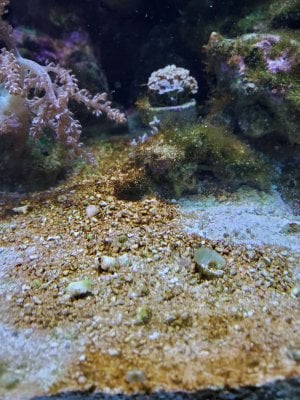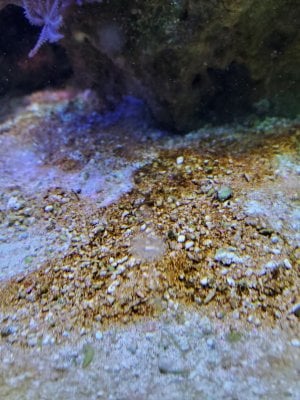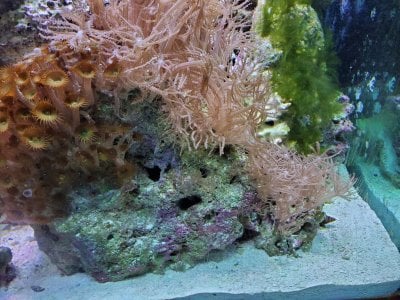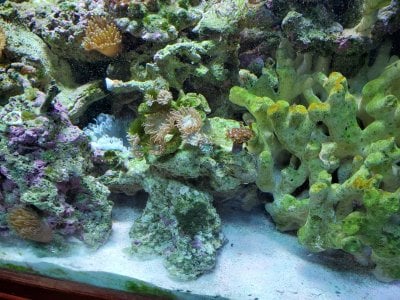I am assuming you saw no movement, correct?
If so, my guess would be chrysophytes. A very light yellow/green?
I've not read much about treatment, but they don't seem to be terribly invasive nor long lasting.
Follow along with the video below to see how to install our site as a web app on your home screen.
Note: This feature may not be available in some browsers.
I am assuming you saw no movement, correct?
That seems to be it! They dont move at all, i guess itll go away by itself. As long as it aint dinos im cool with it lolI am assuming you saw no movement, correct?
If so, my guess would be chrysophytes. A very light yellow/green?
I've not read much about treatment, but they don't seem to be terribly invasive nor long lasting.
Yes, this is known to happen with ostreopsis, but is rarely reported in the hobby.Anyone ever experienced asthma like symptoms when having dinos in the tank? Since i have dinos (on sand only) I experience problems with breathing in my flat, when I am somewhere else I don't have any problems. My girlfriend has the same symptoms. There are some publications on Karenia brevis blooms causing asthma like symptoms. Could this also be caused by the dinos in our tanks?
I now removed all the dino affected sand and added GAC, hope that improves things. Don't want to pull down my tank because of this...
that's weird to see two of these super unusual ones in rapid succession. But I agree it looks like chrysophytes, if that's a high power image.Could anybody ID these? Not the best picture, but any help would be appreciated. No movement in these organisms that I could see.
Yes, this is known to happen with ostreopsis, but is rarely reported in the hobby.
"Ostreopsis blooms in the Mediterranean Sea are commonly accompanied by respiratory problems and skin irritation in humans exposed to marine aerosol containing algal toxins and/or cells debris and seawater [9,10,11,12] due to ability of some Ostreopsis species to produce toxins. Most of these toxins belong to the palytoxin (PLTX) group. PLTX and its analogs may affect human health by ingestion of contaminated seafood, skin contact with seawater, and inhalation of marine aerosols containing Ostreopsis cell debris and/or their toxins [12,13,14].
link here
Oh dear, they look a lot like my dinos:
Is this ostreopsis?
Are there any quick fixes? I just switched off the skimmer so less aerosol is produced, I really have to solve this quickly, my asthma is really bad at the moment, otherwise I have to get rid of the tank.

 www.reef2reef.com
www.reef2reef.com
So far I'm holding steady. It's been about a month since I've seen any sign of dinos in my tank. I got my nutrients up, introduced live rock from an 8yr old neglected tank that was covered in gha, and did elegance corals dino treatment for 3 weeks followed by a course of Dr. Tims. I just accidentally overdosed my nitrates, but thankfully no ill effect yet. Here are my before and after pics. My coral all look so much healthier. My btas are actually bubbling and not all stringy like they used to be.Pretty frustrated. Spent a few months getting my nutrients up, overdosed po4 and they went through the roof (Unreadable by Hanna Checker). Used GFO to bring it back down to 0.14 and has been holding steady with nitrates at 10. During this time large mats of green cyano were on the sand. Vaccumed it all out and two days later boom dinos everywhere worst than ever. Dark Brown stringy and suffocating all my corals, lps are shrunk, acros starting to stn. I've had UV since day 1 and my bulb just happened to burn out after I cleaned up all the cyano.
Tank is year and half old, Just when everything was starting to come together something always comes and beats you back. I'm beginning to wonder if anyone has ever beaten a large dino outbreak.




Sorry about the setback, but it is, sadly, very common. The cycle from dinos to cyano is almost a given, ideally followed by some algae. I relapsed at least three times with ostreopsis, but each time it got easier to reverse.Pretty frustrated. Spent a few months getting my nutrients up, overdosed po4 and they went through the roof (Unreadable by Hanna Checker). Used GFO to bring it back down to 0.14 and has been holding steady with nitrates at 10. During this time large mats of green cyano were on the sand. Vaccumed it all out and two days later boom dinos everywhere worst than ever. Dark Brown stringy and suffocating all my corals, lps are shrunk, acros starting to stn. I've had UV since day 1 and my bulb just happened to burn out after I cleaned up all the cyano.
Tank is year and half old, Just when everything was starting to come together something always comes and beats you back. I'm beginning to wonder if anyone has ever beaten a large dino outbreak.
Oh dear, they look a lot like my dinos:
Is this ostreopsis?
Are there any quick fixes? I just switched off the skimmer so less aerosol is produced, I really have to solve this quickly, my asthma is really bad at the moment, otherwise I have to get rid of the tank.
Anyone? Just in case I have uploaded it to the web as I can never play with the built in player
Hi all,
Managed to capture a video of what I think is Dino. Unsure of the ID and the treatment after all they are back. sorry about the quality but this is an old microscope...
It is my second run of dino outbreak in my tank however I have made a mistake and wanted to clear them too quickly and did a water change after the first session together with cleaning the sand causing my Nitrate go to 0 and they are back. Not a surprise
What I have done is dosed potassium Nitrate and KH2po4 to get my levels detectable. Also running a 18W UV in 39g tank.
I have tried to use dino x to finish them off but not sure if that has done any good.
I have only a few zoa in the tank as it is quite new only 5 months old.
phosphate is about 0.5-1ppm and nitrate is 10-20ppm since it is API test I don't fully trust it but it is but not 0 what matters for now.
Can you help please?
Anyone? Just in case I have uploaded it to the web as I can never play with the built in player

 www.reef2reef.com
www.reef2reef.com
Unusual coloring. The pink one looks like large cell amphidinium. But I have never seen a pink one before.What do I have at 400x no movement
I have a splattering of pink ones idk 3-5% maybe the rest are the other kind.Unusual coloring. The pink one looks like large cell amphidinium. But I have never seen a pink one before.
Are they largely on the sand as amphids prefer?

